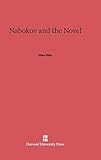Nabokov and the Novel / Ellen Pifer.
Material type: TextPublisher: Cambridge, MA : Harvard University Press, [2013]Copyright date: ©1980Edition: Reprint 2014Description: 1 online resource (197 p.)Content type:
TextPublisher: Cambridge, MA : Harvard University Press, [2013]Copyright date: ©1980Edition: Reprint 2014Description: 1 online resource (197 p.)Content type: - 9780674421479
- 9780674421486
- 813/.54 19
- PG3476.N3 Z8
- online - DeGruyter
| Item type | Current library | Call number | URL | Status | Notes | Barcode | |
|---|---|---|---|---|---|---|---|
 eBook
eBook
|
Biblioteca "Angelicum" Pont. Univ. S.Tommaso d'Aquino Nuvola online | online - DeGruyter (Browse shelf(Opens below)) | Online access | Not for loan (Accesso limitato) | Accesso per gli utenti autorizzati / Access for authorized users | (dgr)9780674421486 |
Frontmatter -- Preface -- Contents -- CHAPTER I. The Question of Character -- CHAPTER II. Consciousness, Real Life, and Fairytale Freedom: King, Queen, Knave -- CHAPTER III. Breaking the Law of Averages: Invitation to a Beheading -- CHAPTER IV. Putting Two and One Together: Bend Sinister -- CHAPTER V. Singularity and the Double’s Pale Ghost: From Despair to Pale Fire -- CHAPTER VI. The Question of Realism -- CHAPTER VII. Heaven, Hell, and the Realm of Art: Adas Dark Paradise -- CHAPTER VIII. On the Dark Side of Aesthetic Bliss: Nabokov's Humanism -- Notes -- Index
restricted access online access with authorization star
http://purl.org/coar/access_right/c_16ec
Ellen Pifer challenges the widely held assumption that Nabokov is a writer more interested in literary games than in living human beings. She demonstrates how Nabokov arranges the details of his fiction to explore human psychology and moral truth, and she argues her case with style. Focusing on the most highly wrought and aesthetically self-conscious of Nabokov's novels, Pifer shows how he deploys artifice to bring into bold relief what is real. In her chapter on King, Queen, Knave she reveals Nabokov's radical distinction between genuine and simulated human existence. She shows how, in Invitation to a Beheading and Bend Sinister, he contrasts "grotesque design" of collective existence with the individul's radiant internal life. In Despair, Lolita, and Pale Fire Nabokov's parody of the double illuminates the unique source of human consciousness. In Ada, as in the earlier Laughter in the Dark, the inhuman nature of aesthetic bliss qualifies its delights. Making clear the moral perception of reality that lies behind Nabokov's artistic strategies, Pifer offers a new assessment of Nabokov's fiction and of his contribution to the tradition of the novel.
Mode of access: Internet via World Wide Web.
In English.
Description based on online resource; title from PDF title page (publisher's Web site, viewed 24. Aug 2021)


